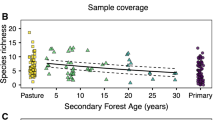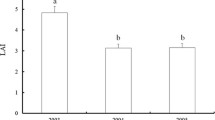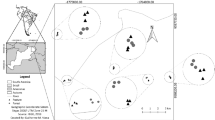Abstract
Ants in tropical forests participate in a wide variety of processes, but human activity can disturb their communities and cause the loss of key species. In this study, we evaluated the effects of human disturbance on the alpha and beta diversity of ant assemblages in a successional gradient of secondary forests growing in abandoned maize fields of the Lacandon region, previously covered by tropical rain forest. Our results show that the alpha diversity of ant species and genera increases with the age of the secondary forests; however, deforestation could cause the loss of certain genera. The turnover of ant species is low along the successional gradient and it is regulated by ecological filters. Secondary forests serve as a refuge for certain ant species and as their successional age increases, they tend to recover the species richness of the mature forest.



Similar content being viewed by others

References
Agosti D, Alonso LE (2000) The ALL protocol: a standard protocol for the collection of ground-dwelling ants. In: Agosti D, Majer JD, Alonso LE, Schultz TR (eds) Ants: standard methods for measuring and monitoring biodiversity. Smithsonian Institution Press, Washington, London, pp 204–207
Aide TM, Cavelier J (1994) Barriers to lowland tropical forest restoration in the Sierra Nevada de Santa Marta, Colombia. Restor Ecol 2:219–229
Anderson MJ, Crist TO, Freestone AL, Sanders NJ (2011) Navigating the multiple meanings of β diversity: a roadmap for the practicing ecologist. Ecol Lett 14:19–28
Benítez-Malvido J, Martínez-Ramos M (2003) Impact of forest fragmentation on understory plant species richness in Amazonia. Conserv Biol 17:389–400
Bihn JH, Verhaagh M, Brändle M, Brandl R (2008) Do secondary forests act as refuges for old growth forest animals? Recovery of ant diversity in the Atlantic forest of Brazil. Biol Conserv 141:733–743
Bolton B (1994) Identification guide to the ant genera of the world. Harvard University Press, Cambridge
Chao A, Shen TJ (2003) Nonparametric estimation of Shannon’s index of diversity when there are unseen species in sample. Environ Ecol Stat 10:429–443
Chase JM (2007) Drought mediates the importance of stochastic community assembly. Proc Natl Acad Sci USA 104:17430–17434
Chase JM (2010) Stochastic community assembly causes higher biodiversity in more productive environments. Science 328:1388–1391
Chase JM, Biro G, Ryberg WA, Smith KG (2009) Predators temper the relative importance of stochastic processes in the assembly of prey communities. Ecol Lett 12:1210–1218
Chase JM, Kraft NJB, Smith KG, Vellend M, Inouye BD (2011) Using null models to disentangle variation in community dissimilarity from variation in α-diversity. Ecosphere 2(2):24. doi:10.1890/ES10-00117.1
Colwell RK (2009) EstimateS: statistical estimation of species richness and shared species from samples. Version 8.2. http://viceroy.eeb.uconn.edu/estimates/
Dirzo R, Raven PH (2003) Global biodiversity and loss. Ann Rev Environ Res 28:137–167
Dunn RR (2004) Recovery of faunal communities during tropical forest regeneration. Conserv Biol 18:302–309
Folgarait PJ (1998) Ant biodiversity and its relationship to ecosystem functioning: a review. Biodivers Conserv 7:1221–1244
Gleason H (1926) The individualistic concept of the plant association. Bull Torrey Bot Club 53:7–26
Guevara S, Laborde J, Sánchez-Ríos G (2004) Rain forest regeneration beneath the canopy trees isolated in pastures of Los Tuxtlas, Mexico. Biotropica 36:99–108
Hammer Ø, Harper D, Ryan PD (2001) PAST: Palaeontological statistics software package for education and data analysis. Palaeontol Electron 4(1):9 (version 2.09)
Hardy OJ (2008) Testing the spatial phylogenetic structure of local communities: statistical performances of different null models and test statistics on a locally neutral community. J Ecol 96:914–926
Ibarra-Manríquez G, Martínez-Ramos M, Oyama K (2001) Seedling functional types in a lowland rain forest in Mexico. Am J Bot 88:1801–1812
Jost L (2006) Entropy and diversity. Oikos 113:363–375
Jost L (2007) Partitioning diversity into independent alpha and beta components. Ecology 88:2427–2439
Kalif KAB, Azevedo-Ramos C, Moutinho P, Malcher SAO (2001) The effect of logging on the ground-foraging ant community in Eastern Amazonia. Stud Neotrop Fauna Environ 36(3):215–219
Lee SM, Chao A (1994) Estimating population size via sample coverage for closed capture-recapture models. Biometrics 50:88–97
Longino JT (2010) The Evergreen State College, Olympia WA 98505 USA. http://llama.evergreen.edu/reports/antsofchiapas/index.html
Longino JT, Colwell RK (2011) Density compensation, species composition, and richness of ants on a neotropical elevational gradient. Ecosphere 2(3):29. doi:10.1890/ES10-00200.1
Longino JT, Coddington J, Colwell RK (2002) The ant fauna of a tropical rain forest: estimating species richness three different ways. Ecology 83:689
Manly BFJ (1997) Randomization, bootstrap and Monte Carlo methods in biology. Chapman & Hall, Cornwall
Marcon E, Hérault B, Baraloto C, Lang G (2012) The decomposition of Shannon’s entropy and a confidence interval for beta diversity. Oikos 121:516–522
Martínez-Ramos M (2008) Grupos funcionales. In: Capital natural de México (ed) Conocimiento actual de la biodiversidad, vol 1. Conabio, México, pp. 365–412
Martínez-Ramos M, García-Orth X (2007) Sucesión ecológica y restauración de las selvas húmedas. Bol Soc Bot México 80:69–84
Miranda F, Hernández XE (1963) Los tipos de vegetación de México y su clasificación. Bol Soc Bot México 28:29–179
O’Brien EM, Whittaker RJ, Field R (1998) Climate and woody plant diversity in southern Africa: relationships at species, genus and family levels. Ecography 21:495–509
Pfeiffer M, Mezger D (2012) Biodiversity assessment in incomplete inventories: leaf litter ant communities in several types of Bornean rain forest. PLoS One 7(7):e40729. doi:10.1371/journal.pone.0040729
Qian H, Ricklefs RE (2007) A latitudinal gradient in large-scale beta diversity for vascular plants in North America. Ecol Lett 10:737–744
Ryder WKT, Mertl AL, Traniello JF (2010) Species diversity and distribution patterns of the ants of Amazonian Ecuador. PLoS One 5(10):e13146. doi:10.1371/journal.pone.0013146
Smith KG, Lips KR, Chase JM (2009) Selecting for extinction: nonrandom disease associated extinction homogenizes amphibian biotas. Ecol Lett 12:1069–1078
R Development Core Team (2009) R: a language and environment for statistical computing. R Foundation for Statistical Computing, Vienna. http://www.R-project.org
van Breugel M, Martínez-Ramos M, Bongers F (2006) Community dynamics during early secondary succession in Mexican tropical rain forests. J Trop Ecol 22:663–674
Woodcock P, Edwards DP, Fayle TM, Newton RJ, Khen CV (2011) The conservation value of South East Asia’s highly degraded forests: evidence from leaf-litter ants. Philos Trans R Soc Lond: Biol Sci 366:3256–3264
Acknowledgments
This research was supported by Grants from SEMARNAT-CONACyT and SEP-CONACyT, Mexico (Grants 2002-01-0597 and 2005-51043) and PAPIIT-UNAM IN227210 to MMR. We thank Dr. Miguel Martínez Ramos of the Centro de Investigaciones en Ecosistemas, UNAM, for providing the facilities used during the field work. We also thank Eric Marcon and coauthors for providing the R code of their program before the official publication of their paper. We thank Israel Estrada for the maps of the region. We are grateful to the Jamangape family for their help with the field work. Finally, this work is dedicated to the loving memory of Ramón Rocha.
Author information
Authors and Affiliations
Corresponding author
Rights and permissions
About this article
Cite this article
Rocha-Ortega, M., Favila, M.E. The recovery of ground ant diversity in secondary Lacandon tropical forests. J Insect Conserv 17, 1161–1167 (2013). https://doi.org/10.1007/s10841-013-9597-1
Received:
Accepted:
Published:
Issue Date:
DOI: https://doi.org/10.1007/s10841-013-9597-1



